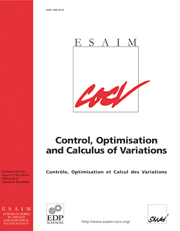Crossref Citations
This article has been cited by the following publications. This list is generated based on data provided by
Crossref.
Вишик, Марко Иосифович
Vishik, Marko Iosifovich
Чепыжов, Владимир Викторович
and
Chepyzhov, Vladimir Victorovich
2006.
Аттракторы диссипативных гиперболических уравнений с сингулярно осциллирующими внешними силами.
Математические заметки,
Vol. 79,
Issue. 4,
p.
522.
Chepyzhov, Vladimir
and
Vishik, Mark
2008.
Instability in Models Connected with Fluid Flows I.
Vol. 6,
Issue. ,
p.
135.
Chepyzhov, V.V.
Pata, V.
and
Vishik, M.I.
2008.
Averaging of nonautonomous damped wave equations with singularly oscillating external forces.
Journal de Mathématiques Pures et Appliquées,
Vol. 90,
Issue. 5,
p.
469.
Li, Hongyan
and
Zhou, Shengfan
2008.
On non-autonomous strongly damped wave equations with a uniform attractor and some averaging.
Journal of Mathematical Analysis and Applications,
Vol. 341,
Issue. 2,
p.
791.
Grasselli, Maurizio
Wu, Hao
and
Zheng, Songmu
2008.
Asymptotic behavior of a nonisothermal Ginzburg-Landau model.
Quarterly of Applied Mathematics,
Vol. 66,
Issue. 4,
p.
743.
Zhao, Caidi
Zhou, Shengfan
and
Li, Yongsheng
2009.
Existence and regularity of pullback attractors for an incompressible non-Newtonian fluid with delays.
Quarterly of Applied Mathematics,
Vol. 67,
Issue. 3,
p.
503.
Wang, Yejuan
and
Zhou, Shengfan
2009.
Kernel sections of multi-valued processes with application to the nonlinear reaction-diffusion equations in unbounded domains.
Quarterly of Applied Mathematics,
Vol. 67,
Issue. 2,
p.
343.
Chepyzhov, V V
Pata, V
and
Vishik, M I
2009.
Averaging of 2D Navier–Stokes equations with singularly oscillating forces.
Nonlinearity,
Vol. 22,
Issue. 2,
p.
351.
Carvalho, A.
Langa, J.
and
Robinson, J.
2011.
Structure and bifurcation of pullback attractors in a non-autonomous Chafee-Infante equation.
Proceedings of the American Mathematical Society,
Vol. 140,
Issue. 7,
p.
2357.
Yan, Xingjie
2011.
Dynamical behaviour of non-autonomous 2D Navier–Stokes equations with singularly oscillating external force.
Dynamical Systems,
Vol. 26,
Issue. 3,
p.
245.
Wang, Yejuan
2013.
On the upper semicontinuity of pullback attractors for multi-valued processes.
Quarterly of Applied Mathematics,
Vol. 71,
Issue. 2,
p.
369.
Bellout, Hamid
and
Bloom, Frederick
2014.
Incompressible Bipolar and Non-Newtonian Viscous Fluid Flow.
p.
347.
2014.
Effective Dynamics of Stochastic Partial Differential Equations.
p.
257.
Chepyzhov, Vladimir V.
Conti, Monica
and
Pata, Vittorino
2017.
Averaging of equations of viscoelasticity with singularly oscillating external forces.
Journal de Mathématiques Pures et Appliquées,
Vol. 108,
Issue. 6,
p.
841.
A. Bekmaganbetov, Kuanysh
A. Chechkin, Gregory
V. Chepyzhov, Vladimir
and
Yu. Goritsky, Andrey
2017.
Homogenization of trajectory attractors of 3D Navier-Stokes system with randomly oscillating force.
Discrete & Continuous Dynamical Systems - A,
Vol. 37,
Issue. 5,
p.
2375.
Faye, Grégory
and
Scheel, Arnd
2018.
Center manifolds without a phase space.
Transactions of the American Mathematical Society,
Vol. 370,
Issue. 8,
p.
5843.
Gao, Peng
2018.
Recurrent solutions of the derivative Ginzburg–Landau equation with boundary forces.
Applicable Analysis,
Vol. 97,
Issue. 16,
p.
2743.
Gao, Peng
2018.
Recurrent solutions of the linearly coupled complex cubic‐quintic Ginzburg‐Landau equations.
Mathematical Methods in the Applied Sciences,
Vol. 41,
Issue. 7,
p.
2769.
Bekmaganbetov, Kuanysh A.
Chechkin, Gregory A.
and
Chepyzhov, Vladimir V.
2019.
Weak convergence of attractors of reaction–diffusion systems with randomly oscillating coefficients.
Applicable Analysis,
Vol. 98,
Issue. 1-2,
p.
256.
Song, Xueli
and
Wu, Jianhua
2020.
Non-autonomous 3D Brinkman-Forchheimer equation with singularly oscillating external force and its uniform attractor.
AIMS Mathematics,
Vol. 5,
Issue. 2,
p.
1484.


